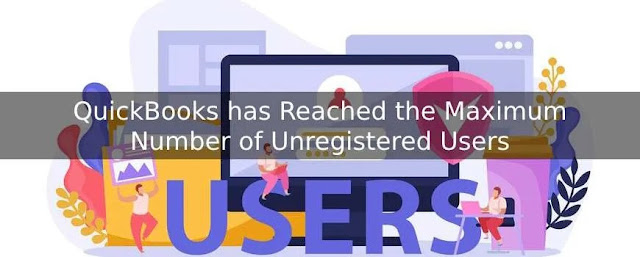QuickBooks Reaches the Maximum Number of Unregistered Users
Are you a business owner using QuickBooks to manage your finances? If so, you may be familiar with the limitations on the number of users that can access your account. QuickBooks has a maximum number of unregistered users, and once you reach this limit, it can pose some challenges for your business. In this blog post, we'll explore what happens when QuickBooks reaches its user limit and provide strategies to avoid reaching that point. We'll also discuss alternatives to QuickBooks that may better suit your business needs. So let's dive in and find the right solution for managing your finances efficiently!
Understanding QuickBooks and Its User Limitations
QuickBooks is a popular accounting software used by businesses of all sizes to streamline their financial processes. It offers a range of features that help users track income and expenses, manage invoices, pay bills, and generate insightful reports. One aspect to be aware of when using QuickBooks is its user limitations.
Every version of QuickBooks has a maximum number of unregistered users allowed. This means that only a certain number of individuals can access the account simultaneously without registering as an official user. Once this limit is reached, you may encounter difficulties in granting access to new team members or external stakeholders who need visibility into your financial data.
Understanding these limitations is crucial for effectively managing your business operations. By knowing the maximum number of unregistered users permitted in your version of QuickBooks, you can plan ahead and make informed decisions when it comes to expanding your team or collaborating with external parties.
To determine whether you're approaching the user limit on QuickBooks, navigate to the "Manage Users" section within your account settings. Here, you'll find information about how many active users are currently utilizing the system and how many additional unregistered users can be granted temporary access.
Reaching the user limit on QuickBooks can have consequences for your business's efficiency and productivity. If there are more people who require access than what is allowed by the software's limitations, it could hinder collaboration among team members or delay critical financial tasks.
Stay tuned as we discuss strategies to avoid reaching this point and steps you can take if you do reach the user limit on QuickBooks!
The Consequences of Reaching the Maximum Number of Unregistered Users
Running a business efficiently requires effective management of all aspects, including finances. QuickBooks has long been a go-to solution for many businesses when it comes to keeping track of their financial records. However, like any software, QuickBooks has its limitations.
One such limitation is the maximum number of unregistered users that can access the system. When you reach this limit, consequences may arise that could hinder your business operations. New employees or team members may not be able to access important financial information in real-time, leading to delays and miscommunication.
Additionally, reaching the user limit on QuickBooks means having to purchase additional licenses or upgrade to a higher-tiered version. This can result in unexpected costs and potential budgetary constraints for your business.
Furthermore, if you continue using QuickBooks beyond its intended capacity by sharing login credentials among multiple users or opting for unregistered access, you run the risk of compromising data security and violating licensing agreements.
To avoid these consequences altogether and ensure seamless financial management within your organization without hitting user limits on QuickBooks, it's essential to evaluate your current user count regularly and plan accordingly. Consider whether it's time to transition to an alternative solution that better suits your growing needs.
Evaluating Your Business Needs and Current User Count
When it comes to managing your finances, it's important to understand the specific needs of your business. Evaluating your business requirements will help you determine the number of users you need on QuickBooks.
First and foremost, take a closer look at your current user count. Are there any inactive or redundant users that can be removed? Streamlining your user list can free up slots for new team members who need access to QuickBooks.
Next, consider the nature of your business operations. Do you have multiple departments that require separate login credentials? Assessing these departmental needs will give you a better idea of how many additional users are necessary.
Furthermore, think about future growth plans for your company. Will there be an expansion in terms of employees or branches? Anticipating these changes will enable you to allocate enough user slots in advance.
Consult with key stakeholders within your organization. Discuss their expectations and whether they require access to QuickBooks for specific tasks or reports. This collaborative approach ensures everyone's needs are met without reaching the maximum limit of unregistered users in QuickBooks.
By carefully evaluating both your business requirements and current user count, you can make informed decisions regarding additional user licenses on QuickBooks while avoiding any limitations down the road.
Strategies to Avoid Reaching the Maximum Number of Unregistered Users
Here are Strategies
to Avoid Reaching the Maximum Number of Unregistered Users:
1. Regularly review your user accounts:
Keep a close eye on your QuickBooks user accounts and regularly evaluate whether each one is still necessary. Remove any inactive or unnecessary users to free up space for new ones.
2. Utilize role-based access:
Take advantage of QuickBooks' role-based access feature to assign specific roles and permissions to different users. This ensures that only those who truly need full access have it, while others are restricted to relevant areas.
3. Train employees on proper usage:
Provide comprehensive training for employees using QuickBooks, so they understand how to navigate the software efficiently without creating duplicate or unnecessary user accounts.
4. Consolidate user accounts where possible:
If you have multiple employee-specific user accounts, consider consolidating them into departmental or team-based accounts instead. This reduces the overall number of users while still allowing for effective collaboration.
5. Upgrade your QuickBooks plan if needed:
If you consistently find yourself reaching the maximum number of unregistered users despite implementing strategies mentioned above, it may be time to upgrade your QuickBooks plan. This will provide you with more available spots for additional users.
By implementing these proactive strategies, you can avoid reaching the maximum number of unregistered users in QuickBooks and ensure smooth operations without any interruptions or limitations caused by exceeding the limit.
Steps to Take When You Reach the User Limit on QuickBooks
So, you've reached the maximum number of unregistered users in QuickBooks. Don't panic! There are a few steps you can take to address this issue and keep your financial management running smoothly.
1. Evaluate Your Current User Count:
Begin by assessing your business's needs and current user count. Determine if all the existing users are necessary or if some can be removed to make room for new ones. This will help you understand how many additional users you actually need.
2. Upgrade Your QuickBooks Plan:
If removing users is not an option, consider upgrading your QuickBooks plan to accommodate more users. Upgrading will provide you with additional user slots, allowing for continued growth without any restrictions.
3. Utilize User Permissions:
Another strategy is to optimize user permissions within QuickBooks. By assigning specific roles and access levels to different users, you can ensure that everyone has the right level of access without exceeding the user limit.
4. Explore Add-On Apps:
If both removing users and upgrading plans are not feasible, consider exploring add-on apps that integrate with QuickBooks. These apps often offer their own user management systems, providing flexibility and expanding functionality beyond what QuickBooks alone offers.
5. Train Existing Users:
It's essential to train your existing users effectively so they fully understand their roles and responsibilities within QuickBooks. By optimizing their efficiency, there may be less need for additional users in the long run.
Remember, reaching the maximum number of unregistered users doesn't have to hinder your financial management process indefinitely; there are several solutions available that can help overcome this limitation seamlessly.
Conclusion: Finding the Right Solution for Your Business Needs
In today's fast-paced business world, it is crucial to have a reliable and efficient accounting software like QuickBooks. However, reaching the maximum number of unregistered users can be quite challenging and may hinder your financial management processes.
To avoid facing this issue, it is important to evaluate your business needs and current user count regularly. By doing so, you can determine whether QuickBooks is still the right fit for your growing organization or if it's time to explore alternative solutions.
If you find yourself in a situation where QuickBooks has reached its user limit, there are steps you can take to address the issue. Contacting Intuit customer support should be your first course of action as they may provide options or guidance on how to overcome this obstacle.
Also Read:- QuickBooks Data Conversion
Moreover, consider implementing strategies that optimize user access by assigning roles and permissions effectively within QuickBooks. This way, you can ensure that only essential personnel have access while avoiding unnecessary unregistered users.
However, if these measures prove insufficient or if you're looking for a fresh start with a new accounting software solution altogether, there are alternatives available in the market. Research and evaluate different options based on factors such as cost-effectiveness, scalability, ease-of-use, and features tailored specifically for your industry.
Finding the right solution for managing finances depends on understanding your unique business requirements and selecting an option that aligns with those needs. Whether it's upgrading your existing QuickBooks plan or switching to another platform entirely – make sure it offers enough flexibility and functionality to support both present operations and future growth aspirations.
Remember that technology evolves rapidly; what works today may not necessarily work tomorrow. Stay proactive in assessing your accounting system periodically so that any potential issues regarding user limits do not disrupt your day-to-day operations.
By taking these necessary precautions into account when using QuickBooks or exploring other alternatives as needed - you'll be able to maintain smooth financial management processes and ensure your business's continued success.




Comments
Post a Comment